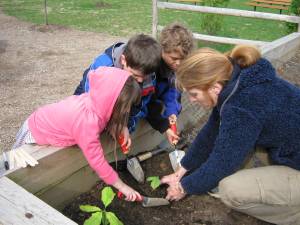GBM Blog
Education and Inspiration: Growing Trees for Peace
 This blog was written by guest blogger and intern in GBM’s US Office, Tara Daniel.
This blog was written by guest blogger and intern in GBM’s US Office, Tara Daniel.
Last summer, GBM shared the story of two kindergarten teachers and the kind hearts of their students with the blog entry, “Big Trees Come From Small Seeds.” At that time, we were writing metaphorically about the power of Professor Maathai and the Green Belt Movement to inspire these small seeds, these young schoolchildren learning about peace. Now, we are honored to announce that the story is also literally true. As Jane Schumer, one-half of the amazing peace team at Daniel Warren School in Mamaroneck, New York, writes, “I am proud to tell you that the dream that Connie Levin and I had in building a Wangari Tree Nursery at our school is now a reality.”
The Wangari Tree Nursery has enriched the learning opportunities associated with the unit Jane Schumer and Connie Levin created with a focus on Professor Maathai and will also provide trees to the village of Mamaroneck. While reading about the planting of trees across Kenya, the two kindergarten classes began following a modified version of the Green Belt Movement’s tree-planting program. They grew native acorns under a growlight last fall and winter then planted the seedlings in the nursery this spring. When the trees grow larger, they will be planted in public spaces throughout the community. The mayor of Mamaroneck has welcomed their donation to the town.
Jane also writes, “Connie and I have continued to share Wangari's story with our classes this year. It continues to inspire both our students, their families and us!” Indeed, the Wangari Tree Nursery is part of a larger peace garden, an enduring testament to the school’s commitment to understanding and cultivating peace among, by, and for its students. While reading about the garden’s adornment by a peace mandala and the transplant of the kindergarteners’ carefully cultivated seedlings, I was struck by the beauty of the garden’s design. The peace garden encompasses various understandings of sustainability and peace that are also reflected in the Green Belt Movement. In addition to the nursery, the garden teaches students about growing food through demonstrating Native American traditions, allowing the students to cultivate their future salads, planting herbs from around the world, and signifying the importance of pollinators. Like GBM’s tree nurseries in Kenya, this garden helps teach respect for indigenous knowledge, the importance of food security, appreciation of cultural differences and distinctions between native and exotic plants, and admiration for the interconnectivity and functionality of ecosystems.
Whether in New York or Kenya, cultivated by kindergarteners embracing a new idea or women seeking a solution, this kind of peace—inextricably connected with learning, growing, and appreciating within nature—will always inspire. With more trees to be grown next year, Jane Schumer, Connie Levin, and their students have planted a legacy of peace with their small seeds, one that will be reflected in each sharing of the story and transplant of a seedling.
